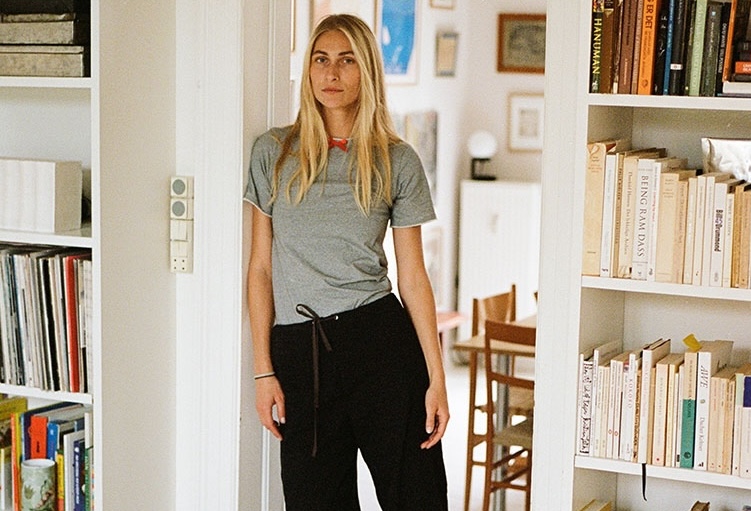Two brothers living halfway around the world from each another, one in Hong Kong and the other in London, wanted to create a shared vacation house in Barcelona, the city where they grew up. They bought a tall ceilinged piano nobile apartment in the Gothic Quarter of Barcelona with a distinctive–and challenging–design feature: a triangular floor plan. In need of a solution that would make the most of their apartment’s geometry, they hired David Kohn Architects of London. The firm responded with a big move: They removed all the interior walls to create one large corner room as a shared living space. But the brothers still needed separate bedrooms and bathroom areas. Nonplussed, the architects maximized the double-height space and fit these in efficiently along the perimeter of the room. And to avoid confusion, they created a complex, 25-color triangular tile pattern on the floor that maps out private as well as shared space, thereby mitigating any sibling rivalry.
Photography by Jose Hevia Blach via Yatzer.

Above: After removing the interior walls of the apartment, the architects created separate bedrooms in furniture-like boxes in each leg of the triangular space. At this end, the box houses two bedrooms–a guest bedroom on the lower level and a bedroom for one of the brothers on the upper level. The encaustic floor tiles were manufactured by Mosaics Martí, supplier of tiles to Antoni Gaudí, and are predominantly green in this section of the apartment.

Above: The bedrooms are just big enough for sleeping.

Above: Built-in wooden louvers can be opened or closed according to sleep requirements.

Above: The apartment’s front door opens onto a brass-glazed entry with a balcony on top. The upper bedroom and its accompanying bathroom behind the gray door are accessed from the balcony.

Above: To differentiate between the brothers’ private spaces, the tile pattern is graded in color from green at one end to red at the other.

Above: The two-story wooden bedroom unit works like a miniature building within the apartment.

Above: The wood-lined interiors create cozy sleeping chambers.

Above: An overall look at the apartment, viewed from the balcony. (The third leg of the triangle is reflected in the mirror at the apex of the room, where the dining table sits.) Metal shelving extends from the balcony, providing library-like storage for books.

Above: The other brother’s bedroom sits above the kitchen, and it too has a balcony that leads to its own bathroom. The floor tiles in this area are predominantly red. For more ideas on tiled backsplashes, see Patchwork Tiles: 11 Mix-and-Match Ideas.

Above: The moveable stairs to this bedroom also function as library stairs.

Above: The dining room table, placed at the apex of the apartment, appears to be twice as long in the mirror’s reflection.

Above: In the shared spaces, the reds and greens in the floor tiles are more evenly mixed.

Above: The distinctive triangular form of the apartment building recalls the Flatiron building in New York City.

Above: A diagrammatic sketch of how the colors in the tile floor change gradually across the apartment. Image by David Kohn Architects.
For more Catalan design, see Midcentury Modern in Barcelona and Let There Be Light: A Pair of Flats in Barcelona Transformed. And on Gardenista, visit A Tiny Glass Studio in Barcelona.
N.B: This post is an update; the original appeared on September 4, 2014, as part of The Organized Life issue.
Frequently asked questions
Who is David Kohn Architects?
David Kohn Architects is a London-based architectural practice known for their carefully crafted and contextually responsive buildings.
What is Carrer Avinyó House?
Carrer Avinyó House is a mixed-use building in the historic El Raval neighborhood of Barcelona, Spain. The building was originally built in the mid-19th century and was remodeled by David Kohn Architects.
What was the scope of the remodel?
The remodel of Carrer Avinyó House involved the renovation of its original features while introducing contemporary elements and new additions. The scope included the creation of a new mezzanine level, the expansion of the living area, and the addition of a new rooftop terrace.
What was the design philosophy behind the remodel?
The design philosophy behind the remodel was to create a dialogue between the existing building and the new interventions. David Kohn Architects sought to balance the preservation of original features with the inclusion of contemporary additions, resulting in a sympathetic and carefully considered space.
What challenges did the architects face during the remodel?
One of the challenges faced by David Kohn Architects during the remodel was the preservation of the building's original features, which had been obscured over time by previous renovations. They also needed to navigate the complex planning regulations for the historic El Raval neighborhood.
What were some of the standout design features of the remodel?
Some of the standout design features of the remodel include the creation of a double-height space in the living area, the use of wood and stone materials throughout the interior, and the new rooftop terrace with views over the city.





Have a Question or Comment About This Post?
Join the conversation